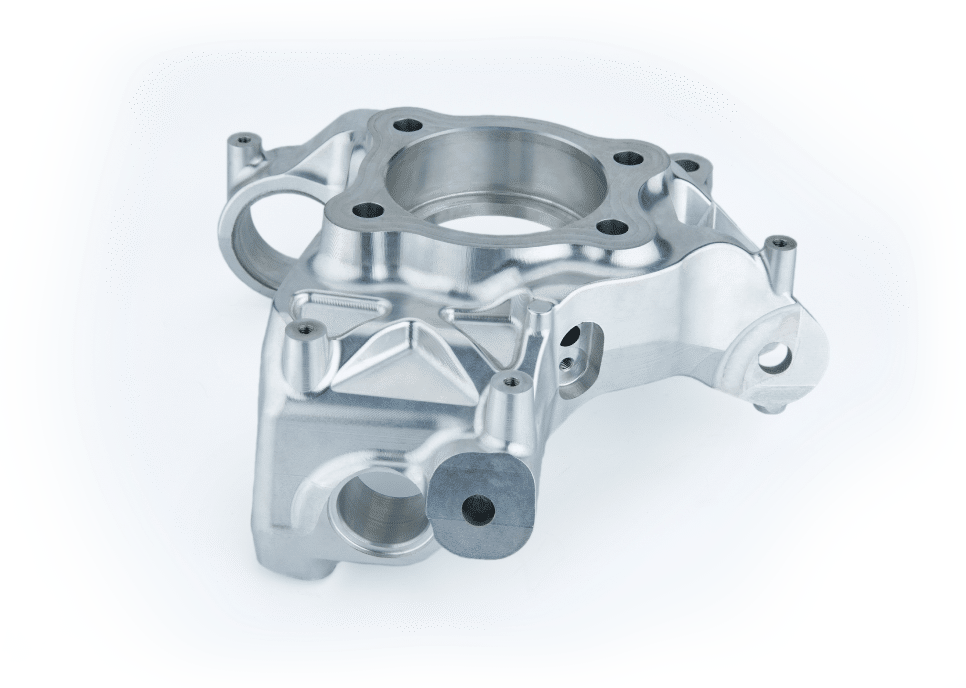CNC machining is a popular way to produce prototypes for many industries. Machinists use CNC prototyping when the design of an object needs tweaking before it reaches the mass production stage.
It can be used to correct any problems that crop up during manufacturing, and this is key in reducing setbacks.
CNC machining can be used as a standalone solution or partnered with other processes like 3D printing to create different iterations of one prototype at relatively low costs compared to traditional prototyping methods such as injection molding, which usually takes over 100 hours just for initial setup!
In today’s article, we’ll be examining how CNC machining can be a foundational part of the rapid prototyping process.
What Is CNC Machining?
Computer Numerical Control (CNC) machining is a manufacturing system that uses a combination of computer inputs and computer controlled machining tools.
The parts needed are designed using Computer Aided Design (CAD) software. Those CAD designs are then translated into a series of instructions that can be understood by the computer controlled machining tools.
These instructions are often referred to as G-code. Once the G-code is running, the CNC process requires little or no oversight. It is also capable of producing prototype parts to very exact specifications.
CNC machining is a subtractive manufacturing process. This means that computer controlled machining tools remove material from a block of material, known as the workpiece.
CNC machines themselves vary in their levels of complexity. The more axes a machine has, the more complicated a geometry it can cut into the workpiece.
Is CNC machining good for prototyping?
As with all rapid prototyping processes, CNC prototyping is an effective solution to certain problems.
Generally, additive manufacturing methods, such as 3D printing, are more commonly used in rapid prototyping, for reasons that we’ve written a whole article about rapid prototyping with 3D printing here..
As a rule, rapid prototypes fall into one of two categories.
The first is a looks-like prototype. These prototypes are used as display models, proofs of concept, or as a physical object that drives the R&D process.
3D printing is an excellent manufacturing solution for these prototypes as it can produce new design iterations very rapidly. These models are not generally placed under stress, so the fragility of most additive manufacturing options isn’t a problem.
The second kind of prototype is the engineering or production prototype. These are designed to be functional and therefore placed under stress.
These prototypes are used to test characteristics like part strength and mechanical stability. These are constructed from materials not commonly available in additive manufacturing processes.
As an example, the design for a valve might be 3D printed as a proof of concept piece. But then, a second engineering prototype might be milled from the proposed production material using CNC machining services. The purpose is to actively test it under working conditions.
The Rapid Prototyping Process with CNC Machining
Rapid prototyping is first conceptualised into the 1970s in response to advances in manufacturing technology. It represents a solution to the bottlenecking of the design process that traditional prototyping represented.
RP allows designers to experiment with a physical model without having to wait a significant amount of time for it to be produced.
The lack of setup and tooling costs associated with rapid prototyping services means that new iterations on a design can be produced quickly and cost effectively.
The advent of new additive and subtractive manufacturing processes, like 3D printing and CNC machining changed the rapid prototyping definition.
Instead of hand milling and injection molding, both of which are slow and expensive by comparison, new proof of concept models can be produced by 3D printing in a matter of hours and CNC prototyping can produce engineering prototypes in a similar time frame.
The rapid prototyping process has a number of advantages, such as:
- The ability to explore concepts in a low-cost low-risk environment. Because of the cost and time effective nature of CNC prototyping and 3D printing, designers are able to explore new designs and new materials with greater freedom.
- Regardless of how good your CAD software is, nothing helps with the communication of ideas more effectively than holding a physical object. This is especially true when using proof of concept models to attract investors or drive sales.
- The speed at which new prototypes can be produced by rapid prototyping services means that designers can quickly and effectively incorporate testing results and feedback into new iterations on the base design.
- A combination of the factors listed above means the employing rapid prototyping alongside new additive and subtractive manufacturing options, allows design departments to more thoroughly test their prototypes and minimize potential design flaws that could have cost and functionality implications later on.

Benjamin S

Mechanical Engineer
"I wish this existed years ago!"
Jiga is the best way to get the parts you need, when you need them.
Advantages and Disadvantages of Rapid Prototyping with CNC Machining
There are a huge range of benefits associated with CNC prototyping and a few drawbacks, including:
Pros
Rapid CAD design changes
One of the primary benefits of rapid prototyping is it allows for rapid iteration of design. This is in response to feedback from testing.
This is especially true for the CAD designs used to create the G-code used for CNC Machining.
Because CAD files are used to instruct the computer controlled machining tools, the designer can be sure that the dimensions of the part produced will exactly match the dimensions on the digital design.
When changes need to be made, the designers or engineers can make those adjustments to a new iteration of the CAD file.
This means that the two iterations of the design can be compared side by side and even tested against each other using simulation software.
Check out our FREE 3D CAD Viewer for Gmail
Machining quality and consistency
Discounting the odd error, cnc machining tools are incredibly precise and consistent. These are able to mill shapes within a fraction of a millimeter.
Just as importantly, this process can be done over and over again without variations in the result.
This level of precision and consistency is hugely important to the interactive design and prototyping process.
Small variations to the design can be made in response to feedback and test. Also, those designs produced without any of the other dimensions changing.
Rapid prototype production
Modern CNC machining services can produce a part in as little as a matter of hours. This makes them just as fast as some 3D printing methods.
Hence, this makes a CNC prototype ideal for products that need short lead times. Which can result to rapidly bringing products to market.
No fixed tooling
Unlike other traditional manufacturing methods, such as die casting or injection molding, CNC prototyping does not need separate specific tools, dies, or molds.
Depending on the complexity of the part, creating the required tools, dies, or molds for prototype production can take as long as a month, not ideal for a rapid prototyping process.
Most modern CNC machines come with a huge range of cutting inserts and milling tools as standard. But, these tools can be switched in and out easily.
This results in both lowered costs and drastically lowered lead times.
A huge range of possible materials
The material that can be cut to shape in a CNC machine is restricted solely by its rigidity and melting temperature. This means a huge variety of materials can be used in CNC prototyping, including:
As you can see, there are a huge range of materials available in CNC machining that are not available in 3D printing.
This is especially true of the range of metals that can be used to create functional engineering prototypes. Since these requires specific tolerances that would not be possible with metal 3D printing.
Cons
Geometric restrictions
While the best CNC machining tools have four or five axes and are able to create parts of significant complexity, they still have certain limitations.
However, this can often be a blessing in disguise. While it is true that you can 3D print parts with far more complex internal geometries than you can cut with a CNC machine, how useful that is will depend on how you plan to produce the final product.
Despite the ubiquity and growing popularity of 3D printing, the vast majority of consumer products and parts are not 3D printed.
Issues with cutting the part on an advanced CNC machine might be an indication that the part is too complex for most end product manufacturing methods as well.
More expensive
The reality is that CNC prototyping is always going to be more expensive than 3D printing.
However, the added costs of using a CNC printing service need to be weighed against the benefits of CNC prototyping we’ve already mentioned.
In certain cases, CNC prototyping is simply the right choice for certain design prototypes and is still less expensive than traditional manufacturing methods.
Wasteful
All subtractive manufacturing methods are, to one extent or another, wasteful. Material is being taken away from the workpiece and that material is then not reused as part of the process.
However, depending on the metal being removed by the CNC machine, the waste might be entirely recyclable or reusable. This is especially true of waste metals, which can simply be melted down and reformed.

Sam H

Manufacturing Business Consultant
"Excellent platform for prototyping & manufacturing"
Jiga is the best way to get the parts you need, when you need them.
Applications of Rapid Prototyping with CNC Machining
There are a large number of industries that are already using CNC prototyping as the foundation of their rapid prototyping designs, including:
The aerospace industry
From increasingly smaller and lighter drones to the parts needed to send billionaires into space, the aerospace industry is in a constant state of iterative development.
While 3D printing can be used to create proof of concept models, CNC machining is required to make testable engineering prototypes out of the materials that the end product will be made from.
Those engineering prototypes then need to be able to have the specific tolerances needed to test them under working conditions. This is especially important in the case of vital sections of an aircraft, where failure of even a small part can be catastrophic.
The automotive industry
For many of the same reasons as the aerospace industry, the automotive industry makes heavy use of both rapid prototyping and CNC machining as part of that process.
The use of CNC prototypes allows automotive manufacturers to create, test, and then iterate on working parts of an engine using the eventual end product materials. New parts can quickly be adapted and machined to exacting geometries and tolerances.
Rapid CNC Prototyping and the Jiga Marketplace
Using the Jiga Marketplace, you can quickly and effectively outsource your CNC prototyping needs to some of the best CNC machine shops in the world.
Receive instant, expert feedback on your proposed design from experienced engineers and order your parts with complete confidence and peace of mind with the Jiga Buyer Protection.
Streamline your prototype creation with Jiga.
You only have one contract, with us, and we handle shipping, payments and legal agreements, saving you thousands of hours on administrative and operational tasks and reducing your lead times.
